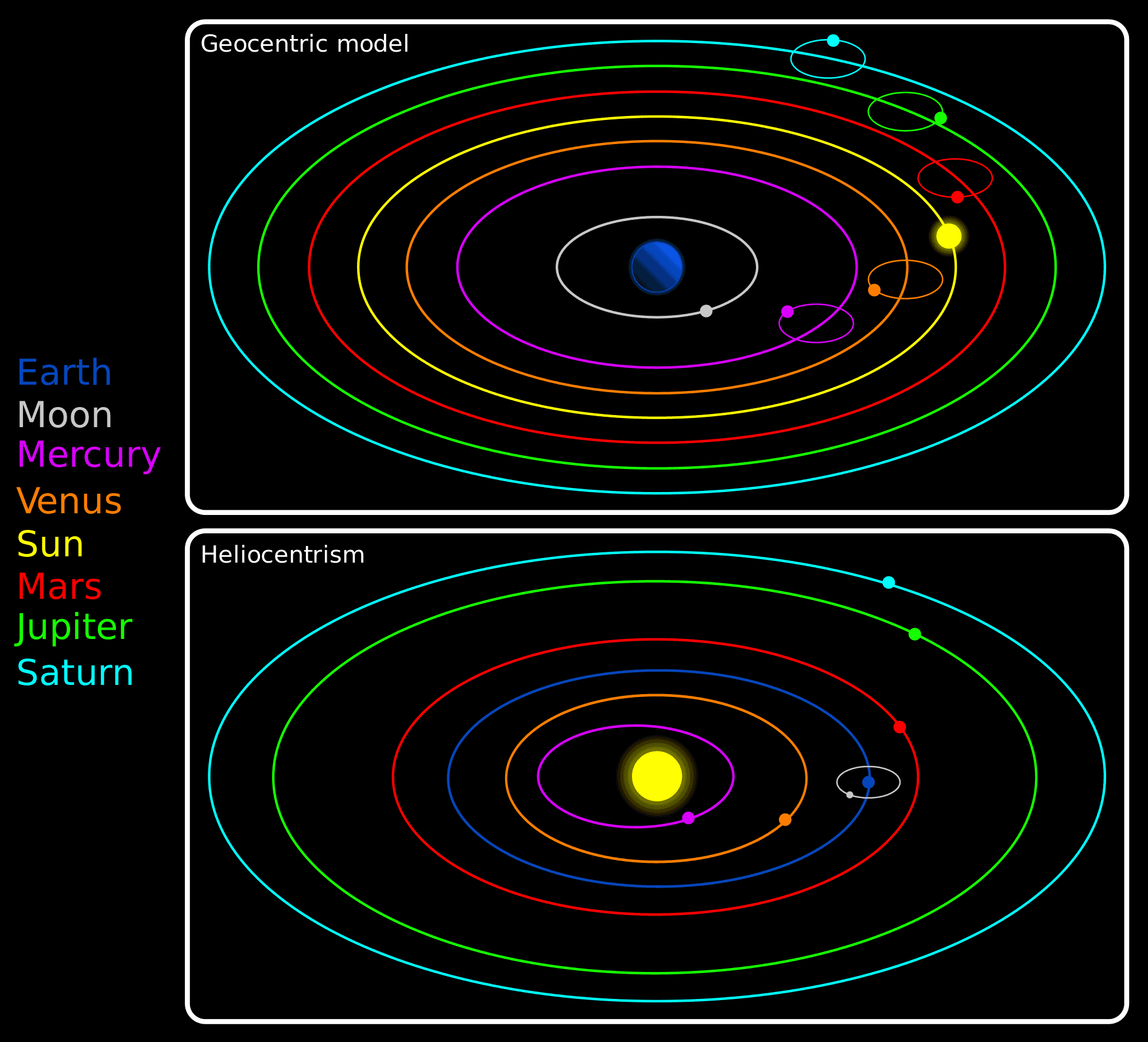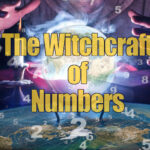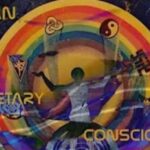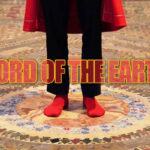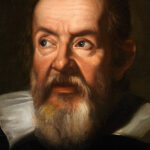300 BC; Greek Philosophers Plato and Aristotle models Geocentric Theory with Earth as a Sphere. Aristotle publishes in his book “On the Heavens”.
200 BC; Greek Aristarchus of Samos placed Earth and other planets in motion around the central Sun but rejected by Aristotleans.
140 CE; Cladius Ptolemy of Alexandria devised complex system of “epicycles” to account for retrograde (going backwards) motion of the planets. Published his theories in book called “Almagest”
200 CE; Ptolemic System developed by Cladius Ptolemaus. “Alamagest”. Geocentric Theory
1270; Roman Catholic church adopts priest Thomas Aquinas theory of a “God-ordained and man-centered” universe which declared the glory of God.
1453; Guttenberg Printing Press developed
1543; Nicholas Copernicus publishes “On the Revolution of Heavenly Spheres” in his last year of his life which postulates a heliocentric, Sun centered, solar system where Earth and planets are revolving around the Sun. “For who would place this lamp of a very beautiful temple in another or better place than this, wherefrom it can illuminate everything at the same time?”
1580; Tycho Brahe, A Danish Astronomer, claimed the most accurate measurement of planet and stars yet still was uncertain of a heliocentric or geocentric model. Was first to suggest a non-circular orbit of planets.
1582 Gregorian Calendar replaces Julian Calendar by Roman Catholic Church by Pope Gregory.
1609; Galileo Galilei grinds his own glass and makes telescope. Observes Venus moons going around Venus “proving” the Heliocentrism. Publishes his work in Italian so all laymen can read instead of scholar Roman Latin. Recants at Roman Inquisition and banished to _____.
1619; Johannes Kepler, German Astronomer student of Tycho Brahe “proved” Heliocentric theory by identifying planet orbits as elliptical and not circular
1687; Sir Isaac Newton, English Astronomer and President of the Royal Society of England, stated “Law of Universal Gravitation” which mathematically showed the force that kept the Earth and planets going around the Sun as well as what kept the oceans in and air from flying away. Wrote the book “Principia Mathematica.
1758 Edmund Halley successfully predicted, using Newton equations, the return of a comet last seen
1822; Congregation of the Holy Office remove heliocentric books from the Vatican banned book list.
1838; Friedrich Bessel measures “Stellar Parrallax” method to measure first distance of star, 61 Cygni.
in 1915, Albert Einstein (1879 – 1955) published the general theory of relativity, in which gravity is not a force but it is a consequence of the curvature of space-time.
****

From as far back as Man has records until the Age of Enlightenment, science and philosophy taught the the Earth was the center of the Universe with the exception of Aristarchus (310-230 BC) who was said to be the first to propose a sun-centered universe.
Plato and Aristotle (300 BC) postulated that the Earth was a sphere but still a geocentric, earth centered universe.
Claudius Ptolemy (85-165 AD) of Alexandria devised a complex system of “epicycles” to account for planets that appeared to go backward, or in retrograde.
The Bible taught that the Earth had four corners and was flat, a plane. Thomas Aquinas (1225-1274), as the Roman Catholic Church was coming to power, stated famously the heavens were “God-ordained and man-centered”.
****

“For who would place this lamp of a very beautiful temple in another or better place than this, wherefrom it can illuminate everything at the same time?” Copernicus defending his heliocentric theory.
Nicholas Copernicus (1473-1543), a priest at the University of Bologna realized that the rising and setting of the Sun, Moon, and stars could be accounted for by a daily revolution of the Earth. Also, he found that if he put the Sun at the center of the planet’s orbits he could simplify the number of epicycles from 80 in Ptolemy’s system to a mere 34.
Although epicycles do not exist, Copernicus was the first to set to prove that the earth, and all planets, rotated around a stable sun not earth. His idea that the Earth and planets orbited about the sun became know as the “heliocentric theory.” He wrote about it in his book “De Revolutionibus, ” which translates to “Concerning the Revolutions.”
However, for his contemporaries, the ideas presented by Copernicus were not markedly easier to use than the geocentric theory and did not produce more accurate predictions of planetary positions. Copernicus was aware of this and could not present any observational “proof”, relying instead on arguments about what would be a more complete and elegant system.
*****

Tycho Brahe (1546-1601) was a Danish astronomer who made measurements of the planet and stars. His measurements were the most accurate that had yet been made. Tycho began his observations in Denmark but later moved to Prague to continue his work.
Tycho proposed a system in which all of the planets except for Earth orbited about the Sun. He claimed that the Sun still orbited about the Earth. As an astronomer, Tycho worked to combine what he saw as the geometrical benefits of the Copernican system with the philosophical benefits of the Ptolemaic system into his own model of the universe, the Tychonic system. Furthermore, he was the last of the major naked eye astronomers, working without telescopes for his observations.
After disagreements with the new Danish king Christian IV in 1597, he was invited by the Bohemian king and Holy Roman emperor Rudolph II to Prague, where he became the official imperial astronomer. He built the new observatory at Benátky nad Jizerou.
There, from 1600 until his death in 1601, he was assisted by Johannes Kepler who later used Tycho’s astronomical data to develop his three laws of planetary motion working without telescopes for his observations.
• Tycho was the first to suggest a non-circular orb it for a celestial body (a comet).
• Used calibrated and bigger instruments, new techniques to measure angles (similar to a sextant).
• Built an observatory (remember – no telescopes yet) and made accurate and continuous measurements for 20 years. His measurements helped to prove that planets orbited the sun.
• Accurate map of the stars with 777 stars.
• Measured length of the year to within 1 second.
• Was still unable to choose between the geocentric and heliocentric model. He had his own model with the Earth at the center, orbited by the sun and the moon, with planets orbiting the sun. Never worked out the mathematical details, and his model was never accepted.
Tycho’s observations of stellar and planetary positions were noteworthy both for their accuracy and quantity. His celestial positions were much more accurate than those of any predecessor or contemporary.
****

Interestingly, before the breakthrough by Galileo of direct observation the Roman Catholic Church led by Pope Gregory adopted the Solar Calendar in 1582. The Gregorian calendar, also called the Western calendar and the Christian calendar, is internationally the most widely used civil calendar.
The calendar was a refinement in 1582 to the Julian calendar amounting to a 0.002% correction in the length of the year.
The Gregorian reform contained two parts: a reform of the Julian calendar as used prior to Pope Gregory XIII’s time and a reform of the lunar cycle used by the Catholic Church, with the Julian calendar, to calculate the date of Easter. The reform was a modification of a proposal made by Aloysius Lilius.
His proposal included reducing the number of leap years in four centuries from 100 to 97, by making 3 out of 4 centurial years common instead of leap years. Lilius also produced an original and practical scheme for adjusting the epacts of the moon when calculating the annual date of Easter, solving a long-standing obstacle to calendar reform.
The Gregorian reform modified the Julian calendar’s scheme of leap years as follows:
Every year that is exactly divisible by four is a leap year, except for years that are exactly divisible by 100, but these centurial years are leap years if they are exactly divisible by 400. For example, the years 1700, 1800, and 1900 are not leap years, but the year 2000 is.
In addition to the change in the mean length of the calendar year from 365.25 days (365 days 6 hours) to 365.2425 days (365 days 5 hours 49 minutes 12 seconds), a reduction of 10 minutes 48 seconds per year, the Gregorian calendar reform also dealt with the accumulated difference between these lengths.(Source)
??? {How the Gregorian Calendar was able to rectify such miniscule timing of the earth rotation before telescopes and why they used a sun centered method when modern history tells us that they supported a earth centered universe, is unclear and undefined and needs to be researched further}.
****
“Though the implications of the new science were not worked out immediately, it began to be suspected that if the theories were true, man had lost his birthright as the creature for whose sake all else existed, and had been reduced to the position of a puny and local spectator of infinite forces unresponsive to his wishes and unmindful of his purposes.” Preserved Smith
In the same era, Italian Galileo Galilei (1564-1642) saw a crude magnifying looking glass at a circus coming through town and got the idea to make a telescope. He learned to grind his own glass and made the first telescope to peer into the heavens.
He used the newly-invented telescope to make his own observations. He studied mountains and craters on the Earth’s moon, the phases of Venus, and the moons of Jupiter. Particularly he noted that Venus at times appears to be a crescent, just as the Earth’s moon does. All of these findings supported Copernicus’ heliocentric theory.
In 1610, Galileo observed that Venus has a full set of phases like the phases of the Moon. It was contradictory to geocentric model where Venus should not have a full lit from the perspective of the Earth.
Actually, Venus phases are result of the orbit of Venus around the Sun inside of Earth orbit so here we see he was incorrect in his theory. (That way, when Venus is between Sun and Earth, it is full shadowy. Then Venus is partially illuminated when it moves in its orbit until it becomes fully lit when it is on the opposite side of the Earth orbit. In sequence, the shadowy is covering Venus when it moving from the opposite side of Earth orbit to the position between Sun and Earth. Thus, Venus has a complete set of phase when complete its orbit around the Sun.)
In the same year, Galileo observed with his telescope four objects moving near the planet Jupiter. After analyzing data of their full period of moving, he concluded that actually these four objects are orbiting the Jupiter as moons. This was unacceptable by the geocentric model where all celestial body should just orbit around a stationary earth.
Galileo’s significance of what he saw:
- Cast doubt on the view of the “perfection of the heavens” (of Aristotle and Plato)
- Showed deficiencies of the geocentric (Ptolemaic) model
- Rotation of sunspots around sun suggested that if the sun could rotate, perhaps the Earth could too.
- Phases of Venus would be a natural consequence of the heliocentric model.
- Jupiter’s moons showed that centers of motion other than Earth existed.
Galileo wrote about his observations and thus angered the Roman Catholic Church. The Church eventually placed him under house arrest. The Inquisition was the tribunal of the Roman Catholic Church at this time. The Inquisition made Galileo kneel before them and confess that the heliocentric theory was false.
Interestingly, Galileo (why do we use his first name?) published in the commoner language of Italian, not Roman Catholic scholarly Latin as to be widely disseminated by the commoner now that books were coming available to the more thanks to book publishing technology.
****

Johannes Kepler (1571 – 1630) was a German astronomer. Kepler was invited to live in Prague by Tycho Brahe. Tycho died a year after Kepler’s arrival. Kepler inherited a wealth of astronomical data from Tycho. In 1594 Kepler accepted an appointment as professor of mathematics at the Protestant seminary in Graz (in the Austrian province of Styria). He was also appointed district mathematician and calendar maker.
Kepler used this data to draw conclusions about the orbits of the planets.
- Why are there only 6 planets?
- How are their orbital periods related to their distance from the sun?
After trying many geometric curves and solids in Copernicus’s heliocentric model to match earlier observations of planetary positions, Kepler found that the model would match the observed planetary positions if the Sun is placed at one focus of elliptical planetary obits. This is Kepler’s First Law of Planetary Motion. Kepler’s three laws of planetary motion allow accurate matches and predictions of planetary positions.
Kepler hypothesized that a physical force moved the planets, and that the force diminished with distance. Planets closer to the sun feel a stronger force and move faster. The concept of a physical force was a monumental step. Kepler was on the verge of assigning physical causes to celestial motions.
Kepler later determined that the orbits were not circular but elliptical.
Terms to know:
- PERIHELION = where a planet is closest to the sun
- APHELION = where a planet is farthest from the sun
The Kepler’s laws are:
- “The orbit of every planet is an ellipse with the sun at a focus.”
- “A line joining a planet and the sun sweeps out equal areas during equal intervals of time.”
- “The square of the orbital period of a planet is directly proportional to the cube of the semi-major axis of its orbit.”
*****
“Nature and nature’s laws lay hid in night; God said “Let Newton be” and all was light. ” Alexander Pope
Sir Isaac Newton (1642 – 1727) lived in England. He was an English physicist and mathematician (described in his own day as a “natural philosopher”) who is widely recognised as one of the most influential scientists of all time and as a key figure in the scientific revolution. His book Philosophiæ Naturalis Principia Mathematica (“Mathematical Principles of Natural Philosophy”), first published in 1687, laid the foundations for classical mechanics.
In 1666, Newton observed that the spectrum of colours exiting a prism in the position of minimum deviation is oblong, even when the light ray entering the prism is circular, which is to say, the prism refracts different colours by different angles. This led him to conclude that colour is a property intrinsic to light—a point which had been debated in prior years. Replica of Newton’s second Reflecting telescope that he presented to the Royal Society in 1672.
He also showed that coloured light does not change its properties by separating out a coloured beam and shining it on various objects. Newton noted that regardless of whether it was reflected, scattered, or transmitted, it remained the same colour. Thus, he observed that colour is the result of objects interacting with already-coloured light rather than objects generating the colour themselves. This is known as Newton’s theory of colour
Newton moved to London to take up the post of warden of the Royal Mint in 1696, a position that he had obtained through the patronage of Charles Montagu, 1st Earl of Halifax, then Chancellor of the Exchequer. He took charge of England’s great recoining, somewhat treading on the toes of Lord Lucas, Governor of the Tower (and securing the job of deputy comptroller of the temporary Chester branch for Edmond Halley). Newton became perhaps the best-known Master of the Mint upon the death of Thomas Neale in 1699, a position Newton held for the last 30 years of his life.
These appointments were intended as sinecures, but Newton took them seriously, retiring from his Cambridge duties in 1701, and exercising his power to reform the currency and punish clippers and counterfeiters. As Warden, and afterwards Master, of the Royal Mint, Newton estimated that 20 percent of the coins taken in during the Great Recoinage of 1696 were counterfeit. Counterfeiting was high treason, punishable by the felon’s being hanged, drawn and quartered.
Newton was made President of the Royal Society in 1703 and an associate of the French Académie des Sciences. In his position at the Royal Society, Newton made an enemy of John Flamsteed, the Astronomer Royal, by prematurely publishing Flamsteed’s Historia Coelestis Britannica, which Newton had used in his studies.
In April 1705, Queen Anne knighted Newton during a royal visit to Trinity College, Cambridge. Newton was the second scientist to be knighted, after Sir Francis Bacon.
Newton was one of many people who lost heavily when the South Sea Company collapsed. Their mostsignificant trade was slaves, and according to his niece, he lost around £20,000. Newton died in his sleep in London on 20 March 1727 and was buried in Westminster Abbey.
The mathematician Joseph-Louis Lagrange often said that Newton was the greatest genius who ever lived, and once added that Newton was also “the most fortunate, for we cannot find more than once a system of the world to establish.

” I do not know what I may appear to the world, but to myself I seem to have been only like a boy playing on the sea-shore, and diverting myself in now and then finding a smoother pebble or a prettier shell than ordinary, whilst the great ocean of truth lay all undiscovered before me” Sir I. Newton
Newton’s Law of Gravity and Motion
Newton derived the law of gravitation between two masses. Since the Sun was the most massive object in the planetary system, all of the planets would naturally be attracted to it and revolve around it, in the same manner as the Moon revolves around the Earth.
Based on Galileo’s and Kepler’s works, Newton published “Principia” in 1687. In this book, Newton posed the theory of Gravity, in which the force that makes planets to move around the Sun is the same force that makes object to fall in the Earth: force of gravity.
In his theory, Newton deduced gravity is a force of mutual interaction of body with mass and this force is inversely proportional to the square of the distance between objects.
The heliocentric model was established by Newton but there were some question about the gravity, for example, its action at a distance and immediately action. Even Newton had doubts about the gravity action at a distance. How can massive objects attract each other at distance without mediation of anything? And how can attraction force between them be immediately without a time to action?
Newton eventually wrote about gravitation and the heliocentric theory in Principia Mathematica in 1687, at the prompting of another famous astronomer, Edmund Halley (1656-1742). Halley used Newton’s equations to predict that a comet seen in 1682 would return in 1758. The return of Halley’s comet gave final proof to the heliocentric theory and is now known as “Halley’s Comet”.

Final “proof”, according to the heliocentric theory for the solar system came in 1838, when F.W. Bessel (1784-1846) determined the first firm trigonometric parallax for the two stars of 61 Cygni (Gliese 820). Their parallax (difference in apparent direction of an object as seen from two different points) ellipses were consistent with orbital motion of Earth around the Sun.
Bessel was a German astronomer, mathematician. He was the first astronomer who determined reliable values for the distance from the sun to another star by the method of parallax. Although he left school at the age of 14, he was appointed in January 1810 as director of the Königsberg Observatory by King Frederick William III of Prussia. Bessel won the Gold Medal of the Royal Astronomical Society in 1829 and 1841.
****
in 1915, Albert Einstein (1879 – 1955) published the general theory of relativity, in which gravity is not a force but it is a consequence of the curvature of space-time. Thus, massive body creates a curve in the space-time then inertial trajectory that was straight lines became curved. These inertial trajectories are called geodesics.
An object can inertial follow a geodesic without an interaction of forces. As consequence, heavy objects create a “big” curvature on space-time that makes other object fall towards them by a geodesic. If an object has extremely big mass even the light will suffer a noticeable deflection. This object is called of black hole.
Einstein’s master insight was that the constant, familiar pull of the Earth’s gravitational field is fundamentally the same as these fictitious forces.
The apparent magnitude of the fictitious forces always appears to be proportional to the mass of any object on which they act – for instance, the driver’s seat exerts just enough force to accelerate the driver at the same rate as the car. By analogy, Einstein proposed that an object in a gravitational field should feel a gravitational force proportional to its mass, as embodied in Newton’s law of gravitation.
****
President Dwight D. Eisenhower established the National Aeronautics and Space Administration (NASA) in 1958. Former SS Nazi, Wernher Magnus Maximilian, Freiherr Von Braun (1912-1977) led NASA’s rocketeers.
Von Braun was already the central figure in the Nazis’ rocket development program, responsible for the design and realization of the V-2 rocket during World War II. His was said to be directly responsible for the killing of prisoners by hanging at the Peenemeunde Rocket Facility he commanded during WWII as well as the death of tens of thousands in England and France from Nazi V-1 and V-2 rockets. (Source)
After the war, he and selected members of his rocket team were taken to the United States as part of the secret Operation Paperclip.

Braun worked on the United States Army’s intermediate-range ballistic missile (IRBM) program before his group was assimilated by NASA. Under NASA, he served as director of the newly formed Marshall Space Flight Center and as the chief architect of the Saturn V launch vehicle, the superbooster that propelled the Apollo spacecraft to the Moon.
According to one NASA source, he is “without doubt, the greatest rocket scientist in history”. In 1975 he received the National Medal of Science. (Source).
Additionally, C. Fred Kleinknecht, head of NASA at the time of the Apollo Space Program, is now the Sovereign Grand Commander of the Council of the 33rd Degree of the Ancient and Accepted Scottish Rite of Freemasonry of the Southern Jurisdiction.
****

In 1992, the Roman Catholic Church finally repealed the ruling of the Inquisition against Galileo. The Church gave a pardon to Galileo and admitted that the heliocentric theory was correct. This pardon came 350 years after Galileo’s death.





